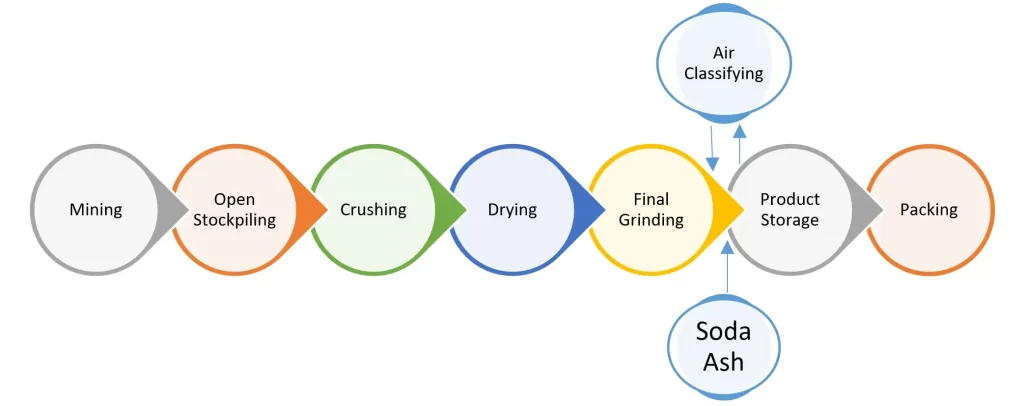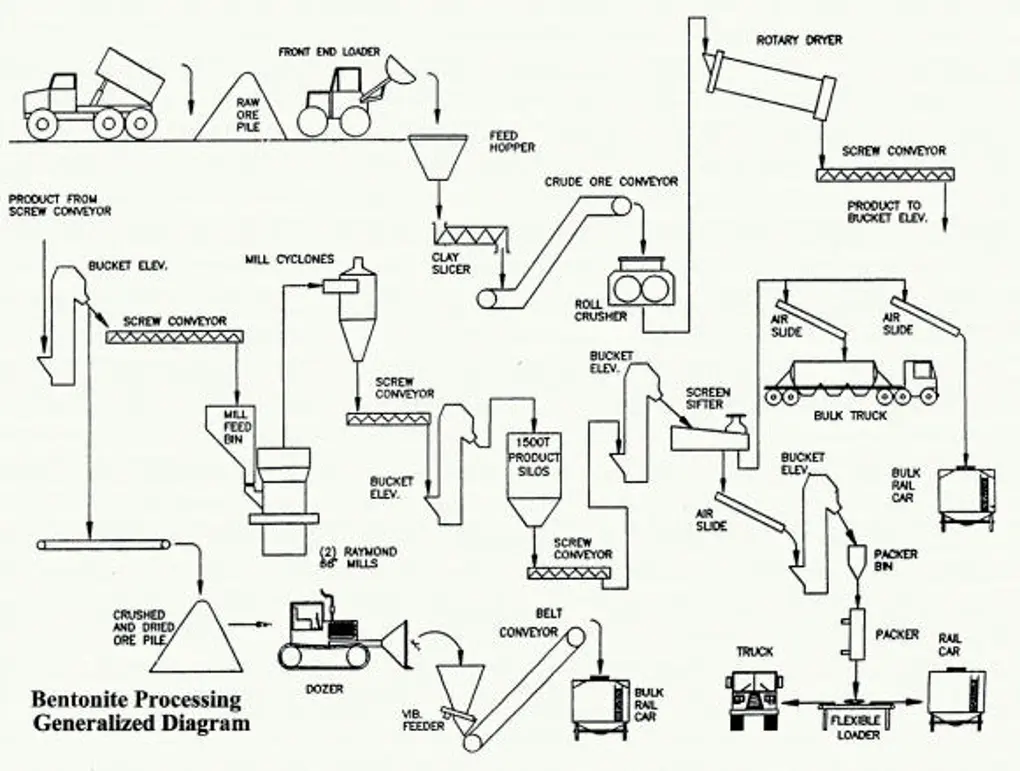Deposits of Bentonite
Deposits of Bentonite are mostly exploited by mining. Having an approximately 30% content of moisture, the extracted Bentonite is noticeably solid. Initially, the material is sliced or crushed and activated by adding Na2CO3 (soda ash), if required. Afterward, Bentonite is dried using forced drying or the air to touch the required moisture. EUBA (European Bentonite Association) provides information on 15% moisture content in Bentonite, which is already dried; WMA (Wyoming Mining Association) in the range of 5% to 20%; and Chinese producers and exporters in the range of 6% to 12%.
Bentonite Screening and Milling
With respect to the final purpose, Bentonite is either screened in the form of granules or milled into the form of powder and superfine powder. For the specific usages, Bentonite gets purified by eliminating the associated gangue minerals or processed with acids to create acid-activated Bentonite or processed with organics to make organoclays. The below Figures show bentonite processing.

Bentonite Manufacturing Process
Bentonite Manufacturing Process
SME Mineral Processing Handbook explains a very simple method for processing.
Step 1: Drying
First, by drying in the rotary kilns to touch the moisture for 5% to 8%, bentonite is processed.
Step 2: Grinding
Second, it is grounded in high-speed roller mills.
Step 3: Size Classification
Third, it is classified into the size grades through sieves and cyclones.
Step 4: Ring Roller Mills
Fourth, using ring roller mills machines, a feed size of 50 mm is ground to different sizes as fine as 0.03 mm or to granulation of 3.3 mm containing a minimum of fines.
Step 5: Fluid Bed Drying
Fifth, wet-fed bentonite containing moisture of 15% to 32% is fluid bed dried to a moisture content of 7% to 11%. Fuller’s earth, having a moisture content of 47%, is fluid bed dried to 30% to 35% moisture.
Step 6: Dust-Free Conveying
Sixth, the Negative pressure air system ends in dust-free conveying. The release and elimination of foreign materials like silica through supporting bottom discharge are achieved at the same time as grinding.
The most important feature of montmorillonites, to regain interlayer water and to expand, is lost if heated (dried) in a temperature higher than 105 °C to 125 °C for Li montmorillonite, 300 °C to 390 °C for H or Ca montmorillonite, and 390 °C to 490 °C for Na montmorillonite. It is safe for the drying temperatures to be up to 205°C for most of the Sodium bentonites. Bentonite may be dried and wetted many times repetitively without losing swelling properties.
In drying bentonite commercially, experience has shown that regaining interlayer water is not easy if the last trace of interlayer water is eliminated, but on condition that some water remains among the layers, swelling is mostly relatively easy.

Bentonite manufacturing process
Overall
Bentonite Processing is quite simple, though, because of its high affinity to absorb moisture; special attention is needed so as to choose the appropriate size reduction device. If the raw bentonite has a considerable moisture content, a primary size reduction in a crusher that employs the effect of comminution might not be effective. Generally, the good choice for the primary crushing of wet and sticky material is the roller crusher, which has specially designed toothed rollers that rip large Lumps of clay into small pieces for more processing. However, jaw crusher and cone crusher may even be applied.
The next steps in bentonite processing are drying it in a rotary kiln and milling it. The order of steps rests on the choice of the mill. If the mill is reactive to the moisture (for example, if milling of the wet material is not enough), the crushed material is dried before the milling. If the mill is of the ring roller mill type or fluid energy mill type that utilizes a fluidized bed or air stream to stimulate drying and conveying, the produced material might be of acceptable wetness for the ultimate product. If not, bentonite might be dried after the milling.
Sources:
hrcak.srce.hr
Rudarsko-geološko-naftni zbornik Journal, Vol. 24, 2012



